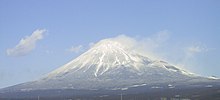Stratovolcano
Layer volcanoes , also stratovolcanoes (from Latin stratum referred to as "layer") are made of individual layers of lava and Locker masses constructed volcanoes . You can recognize them by their relatively steep, conical shape. Because of the "gray", non-glowing extraction products, they are sometimes also referred to as "gray volcanoes".
Emergence
The main reason for their formation is the silicon content of the magma , which in such volcanoes is usually between 55 and 60%. As a result, the magma is relatively viscous - it does not flow very far and forms thick lava flows. It is mostly differentiated magma, i.e. magma that has developed from basaltic magma, or magma that is created by melting down the lower part of the earth's crust . It is relatively cold with around 700 to 900 ° C. The high proportion of gas causes the eruptions to be explosive, mostly alternating between escaping loose material, called tephra ( bombs , lapilli , ashes ) and lava. Such a sequence causes the characteristic stratification when it cools and deposits, which gives this type of volcano its name.
The violence of the volcanic eruptions, also known as Plinian eruptions , is so great in this form of volcanism that the volcanic loose masses can be thrown into the earth's atmosphere as volcanic ash up to heights of 40 km .
If the volcano's magma chamber then collapses, its summit is replaced by the caldera , in which a new volcanic cone forms. This shape is called the Somma volcano , after the classic example of Vesuvius , which consists of the older Monte Somma and the younger Vesuvius cone proper. Other examples of Somma volcanoes are the Pico de Fogo on Cape Verde and the Avatscha on Kamchatka .
The activity of stratovolcanoes is often interrupted by long periods of rest, during which the lava solidifies in the volcanic vent. If the magma cannot penetrate the old chimney during the renewed ascent, the axis of the eruption will shift and the new crater will appear on the flanks of the old cone. If it remains smaller than the older volcano, one speaks of an adventitious or flank volcano . Two stratovolcanic cones of roughly the same size are called twin or double volcanoes . The Chimborazo and Elbrus , for example, have this shape .
Occurrence
Of the around 1500 active volcanoes worldwide (erupted in the last 10,000 years) around 700 are stratovolcanoes.
Most stratovolcanoes are found in subduction zones z. B. along the Pacific Ring of Fire , but also on Iceland and the Mediterranean .
Some of their most famous representatives of Mount Fuji in Japan , the Mount St. Helens in the United States , the Pinatubo and Mayon in the Philippines , the Vesuvius in Italy , the Etna on Sicily , the Lanín in Argentina , the Snæfellsjökull in Iceland , Merapi on Java and the Ararat in Turkey.
The highest stratovolcano on earth is the Nevado Ojos del Salado in Chile with 6887 m .
The Kaiserstuhl is a low mountain range in Germany that has its origin in a stratovolcano.
literature
- Alfred Rittmann : Volcanoes and their activity . Ferdinand Enke Verlag, Stuttgart 1981, ISBN 3-432-87793-5 .
See also
Web links
- Stratovolcano in the Global Volcanism Program (English)
- V. Camp: Stratovolcanoes , How Volcanoes Work , Dept. of Geological Sciences, San Diego State University (English)
Individual evidence
- ↑ Global Volcanism Program (English)
- ↑ Gerd Simper: Understanding and experiencing volcanism . Feuerland Verlag, Stuttgart 2005, ISBN 978-3-000-15117-0 , p. 38




